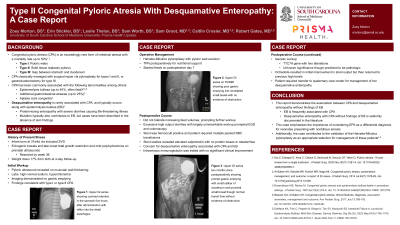Pediatrics
Category: Quickshot Oral Session 26
Quickshot Oral : Quickshot Oral Session 26
TYPE II CONGENITAL PYLORIC ATRESIA WITH DESQUAMATIVE ENTEROPATHY: A CASE REPORT
Tuesday, February 14, 2023
7:00am - 8:00am East Coast USA Time

- RG
Robert Gates, MD
United States

ZOEY MORTON, BS
Medical Student
Greenville Health System, United States
Principal Contact(s)
Presenter(s)
Objectives: Congenital pyloric atresia (CPA) is a very rare condition that presents as a gastric outlet obstruction in the first few days of life. CPA is typically isolated and carries a good prognosis however it may also be associated with other conditions such as multiple intestinal atresia and epidermolysis bullosa (EB) which worsen the overall prognosis.
Methods: This report describes a four-day-old infant who presented with nonbilious emesis and weight loss. Ultrasound and upper GI series revealed gastric outlet obstruction but no evidence of pyloric stenosis, most consistent with pyloric atresia. The patient has undergone workup and ongoing management at Greenville Memorial Hospital Children’s Hospital.
Results: The patient underwent operative repair via Heineke-Mikulicz pyloroplasty. She was found to have a thickened pylorus extending the length of the entire muscle consistent with type II pyloric atresia. Postoperatively, she was able to take breast milk but developed severe diarrhea and was found to have a desquamative enteropathy although had no skin findings concerning for EB.
Conclusion: This report demonstrates the association between CPA and desquamative enteropathy without EB, with only one other case report documented in the literature. It also emphasizes the importance of considering CPA as a differential diagnosis for neonates presenting with nonbilious emesis, validates Heineke-Mikulicz pyloroplasty as the surgical treatment option, and discusses the workup necessary to confirm the diagnosis.
Methods: This report describes a four-day-old infant who presented with nonbilious emesis and weight loss. Ultrasound and upper GI series revealed gastric outlet obstruction but no evidence of pyloric stenosis, most consistent with pyloric atresia. The patient has undergone workup and ongoing management at Greenville Memorial Hospital Children’s Hospital.
Results: The patient underwent operative repair via Heineke-Mikulicz pyloroplasty. She was found to have a thickened pylorus extending the length of the entire muscle consistent with type II pyloric atresia. Postoperatively, she was able to take breast milk but developed severe diarrhea and was found to have a desquamative enteropathy although had no skin findings concerning for EB.
Conclusion: This report demonstrates the association between CPA and desquamative enteropathy without EB, with only one other case report documented in the literature. It also emphasizes the importance of considering CPA as a differential diagnosis for neonates presenting with nonbilious emesis, validates Heineke-Mikulicz pyloroplasty as the surgical treatment option, and discusses the workup necessary to confirm the diagnosis.

